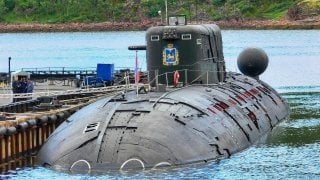Russia's Titanium Sierra-Class Submarines: A Nightmare for the U.S. Navy
While the Sierra-Class performed admirably for the Soviet Union and now Russia, the cost and difficulty of constructing a titanium hull was deemed not worth the effort.
Russia's Sierra-Class Submarines were built to sink the U.S. Navy in a war - Soviet submarine designers subverted expectations when they began building hulls from titanium instead of default steel. The titanium hulls had benefits – and also drawbacks, which is why the Americans never followed with a titanium-hulled submarine of their own.

And the Soviets, despite the novel incorporation of titanium, never relied on the metal for the backbone of their submarine fleet; only a handful of Soviet/Russian submarines were constructed from titanium, including the Sierra-class.
Cold War Innovation on Submarines
During the 1960s, while the Cold War raged, Soviet designers began experimenting with different submarine hulls.
Titanium had never been used to build a submarine before – but the metal had qualities that the Soviets were attracted to – namely, low density and high strength.
The Soviets gave titanium a try, building the world’s first titanium submarine, the Project 705 Lira.
The titanium Lira entered the Soviet Navy in 1971 as one of the fastest submarines ever built.
Why did the Soviets use titanium? “Titanium alloy is usually stronger than steel but weighs half,” defense expert Brent Eastwood wrote. “It is more expensive, up to three to five times more than steel. Titanium is also less corrosive in salt water. It can handle more pressure during deeper dives – all the way down to 2,200 feet.”
But crafting a submarine out of titanium is not a simple process; welding titanium “is difficult and the slightest mistake during the welding phase could make the titanium brittle and less strong,” Eastwood wrote.
Still, the Soviets proceeded to design another titanium submarine, the Project 945 Barrakuda and the Project 945A Kondor, which NATO reported as Sierra I and Sierra II, respectively.
Sierra-Class Submarines, Explained
The Soviets built just four Project 945 Sierra submarines (two Sierra Is and two Sierra IIs).
Like the Lira, the Sierras were distinct for their titanium hull, allowing the submarine to dive to greater depths while reducing the emission of radiated noise and increasing resistance to torpedo attacks.
The Sierra II, each of which were commissioned in the 1990s, was an upgraded version, designed specifically for search and destroy missions against US nuclear submarines. The Sierra II had speeds and diving depths that were superior to American models of the period.
Today, the Sierra Is – the Carp and the Kostroma – are on reserve status. Meanwhile, the Sierra IIs – the Nizhniy Novgorod and the Pskov – are still on active duty.

The Sierra II was slightly larger than the Sierra I. The Sierra I displaced 8,300 tons submerged, with a 351-foot length, 40-foot beam, and 29-foot beam.
The upgraded Sierra II, however, displaced 9,100 tons submerged, with a 360-foot length, 47-foot beam, and also, 29-foot draft.
Both Sierra variants relied on one OK-650 pressurized water reactor (PWR) capable of providing 1,002 horsepower and 747 kilowatts of energy.
Submerged, the Sierra I could reach speeds of 34 knots. The larger Sierra II topped out at 32 knots. Neither Sierra variant could match the 40-knot-plus speed of the Lira-class.
The Sierra-class was overshadowed within the Soviet Navy, Robert Jensen wrote, despite being fairly capable relative to their peer submarines. The Sierra “promised to be more capable, longer legged, and more lethal than the second-generation Victors, Charlies, and Alfas that populated the Soviet undersea fleet entering the 1980s. Faster and deeper diving than the Victors and Charlies, with greater endurance and more – and better – weapons than the Alfas, the Sierra had the makings of the ultimate Soviet attack boat. Yet, today, they’re only remembered by those interested in Soviet attack submarines.”

The Soviets did not keep building the Sierra, in part, because the thing was just so hard to build. “The fully titanium hull was labor and cost intensive,” Jensen wrote, “even more so than that of the high-performance [Lira].”
The Sierra, like the Lira, was very fast. “Titanium provided the necessary performance to get these hunters faster than anything they might have come across in the world’s oceans,” Jensen wrote, who believed the Sierra was “possibly the best all-around attack submarines the Soviets built during the Cold War.” Why? Because the Sierra was “fast, lethal, and made of titanium.”
The Downsides of Titanium
While the Sierra performed admirably, the cost and difficulty of constructing a titanium hull was deemed not worth the effort.
The United States came to a similar conclusion with respect to titanium hulls – although the US came to the conclusion before ever building a class of titanium submarines.

“The United States…took a close look at the titanium construction,” Eastwood wrote. But “titanium is rare and costly compared to iron. Titanium is not easy to shape either,” meaning that the margin of error when constructing the titanium hulls were small. “Any mis-step by the welders would create a sub that would be dangerous to take on deep dives.”
Both the Americans and the Soviets/Russians ultimately decided that titanium hulls, like the Sierra-class, were not worth the effort.
About the Author
Harrison Kass is a defense and national security writer with over 1,000 total pieces on issues involving global affairs. An attorney, pilot, guitarist, and minor pro hockey player, Harrison joined the US Air Force as a Pilot Trainee but was medically discharged. Harrison holds a BA from Lake Forest College, a JD from the University of Oregon, and an MA from New York University. Harrison listens to Dokken.


